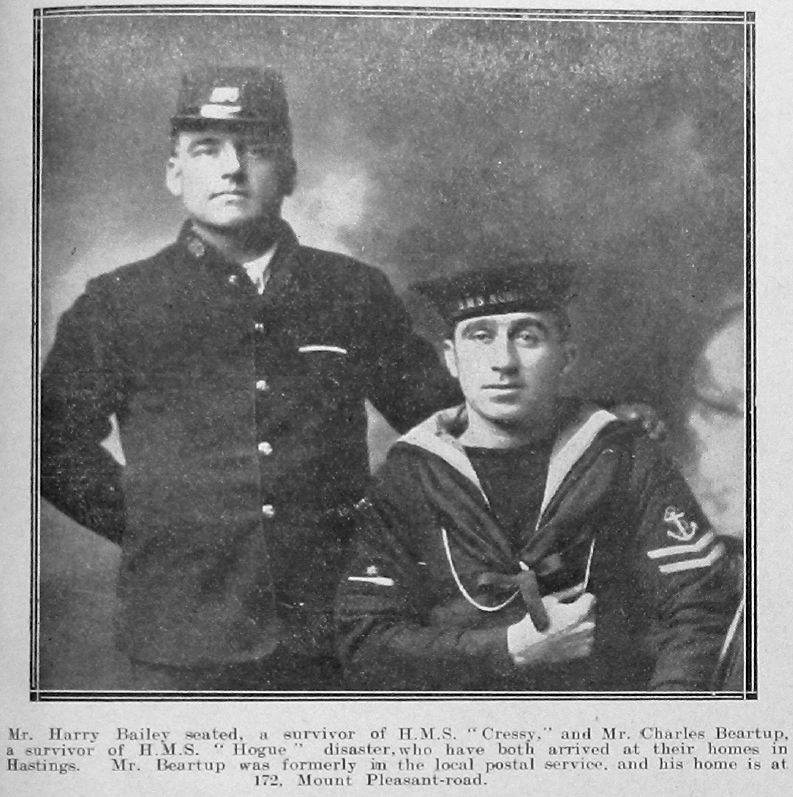 Navy
Navy
Beartup, Charles

Charles Beartup
Ship: HMS Hogue
Address: 172 Mount Pleasant Road, Hastings
Other Info: Charles was formerly in the local postal service. Was one of the men saved from HMS Hogue when it was sunk, along with sister ships HMS Cressy and HMS Aboukir, by German submarine U-9 on 22nd September 1914.
An article published in the Hastings & St Leonards Observer on 3rd October 1918 reads: “Mr Charles Beartup, of Mount Pleasant Road, a Naval Reservist and a member of the Hastings Postal Staff, and Mr Harry Bailey, also of Hastings, have arrived home after thrilling adventures.
Mr Beartup, who speaks with much feeling of the kindness of Hastings Postal Staff, is looking very well in spite of the terrible experience through which he has passed. The ‘Aboukir’ was the first of the three ships which was struck, and it was at was first supposed that she had been blown up by a mine.
The men on the ‘Hogue’ went to their stations immediately, and the launch and boats were lowered to the assistance of the ‘Aboukir’. “We’ve got it now” was the exclamation when the ‘Hogue’ was torpedoed. Mr Beartup ridiculed the idea that only one German submarine was concerned. A submarine can only carry a limited number of torpedoes, and it was supposed that at least three struck the ‘Hogue’.
What impressed Mr Beartup was the remarkable coolness which everyone displayed. The launch had been got out, and the derrick was back to get out another boat when the ‘Hogue’ shared the fate of her sister ship, and sank in six minutes. Everything that could help those in the water was thrown overboard. Even hammocks, when lashed, are useful supports in the water, as they float until they get thoroughly wet.
Mr Beartup was wet through before he got in the water. The explosion sent a pillar of water, like a waterspout, over the vessel. Mr Beartup found himself next to his commander, who said “Are you still there? Look after yourself. Goodbye. Away you go”. He called out to a big marine to follow him, but he did not know what became of him. Mr Beartup, with very little clothes on, made for the launch.
He was in the water for about an hour. They were eventually picked up by a Lowestoft Trawler. “I shall never forget her number – 369 – as long as I live” said he, laughing. “We were pleased to see the old British flag again. If I had money enough I would fit that man out with a motor boat”.
The ‘Cressy’ was the last ship to sink. A pathetic, but inspiring, sight it must have been to see the survivors cheering their old ships and waving their hands as they saw the last of them. Some poor fellows who could not swim had to give up and go down. The sea was choppy, and even the swimmers were sick with salt water.
Afterwards Mr Beartup and others were put in a light cruiser of the type that the Germans don’t like because they can get anywhere. “We have seen the last of the old type of ships” said he.
The return, through Shotley and Harwich, and southwards, was like a triumphant march, in spite of the sadness. Everywhere, on the trawler, on the cruiser, and on land Mr Beartup and the survivors were overwhelmed with kindness. At one place they were cheered by wounded Germans in hospital as well as by their own people.
Mr Beartup again met his friend and fellow Hastinger, Mr Bailey, at Harwich”.
Published: September 1914 & October 1914
Please use the comments box below if you can provide more information about this person.